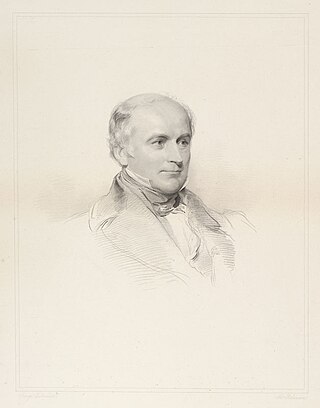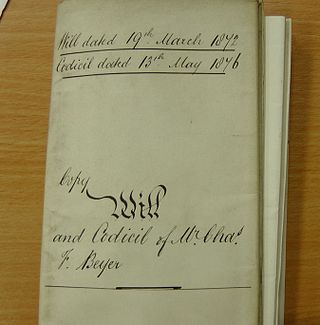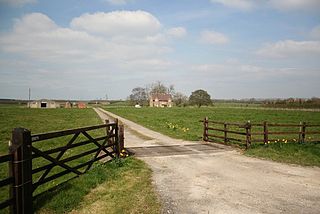Common law authority
The major common law authority in this area is Re Oldham [1925] Ch. 75. This discussed the 18th-century case of Dufour v Pereira which first evinced the doctrine, in which Lord Camden remarked "he, that dies first, does by his death carry the agreement on his part into execution". Astbury J in Oldham distinguished mutual wills from mirror wills - that they are made in identical terms "does not go nearly far enough". There must be "an arrangement proved to the satisfaction of the court" and this must be a binding, irrevocable agreement.
In Re Cleaver [1981] 1 WLR Nourse J took a less strict approach in finding that identical wills went towards proving the existence of an agreement, however, this approach was rejected in Re Goodchild [1996] 1 WLR [4] where Carnwath J stated the importance of having specific evidence as to the testator's mutual intentions at the time of execution of the wills. Carnwath J approved the "floating trust" analogy, first proposed by Dixon J in Birmingham v Renfrew [1937] CLR, which holds that the law will give effect to the intention (to create a mutually binding will) by imposing a floating trust which becomes irrevocable after the death of the first testator and crystallises after the death of the survivor.
In the Court of Appeal decision in Goodchild Legatt LJ approved the dicta of Carnwath J and added that "for the doctrine to apply there must be a contract". This approach raises problems as will be seen below. However, the contractual requirement has been rejected in other decisions or at least diluted. Dixon J in Birmingham, commenting on Dufour v Pereira, noted that it is the trust arising from the course of conduct which is enforced, not the contract itself. This approach has received further credence in the decision of Blanchard J in Lewis v Cotton. "A formal legal contract is not needed. A contract made without formality is enough...The crucial factor must be that the terms of the mutual engagement... are sufficiently certain that the Court can see its way to enforce them." The importance of this approach is, as Blanchard J notes, that the focus is on the obligation not to deal with property contrary to the agreement rather than on non-revocation. This, therefore, covers situations such as that in Healey v Browne where there has been an inter vivos transfer to avoid the will.
In Healey v Browne [5] a husband transferred assets jointly to himself and his son after the death of his wife. Although there was found to be no mutual will (Donaldson QC adopted the contractual requirement), he considered that where there was a valid mutual will the second testator is free to use the assets for his own beneficial interest as long as it is not calculated to defeat the agreement: "Where the fiduciary duty is breached by such a voluntary disposition inter vivos of the property in question, the "crystallisation" of the floating obligation must occur at the moment of that disposition." (Note that Donaldson QC imposed a secret trust in the circumstances which reduced the son's interest to 50%, that being the interest held by the husband)
In Olins v Walters [2009] 2 WLR 1 C.A. [6] the Court of Appeal has held that although it is a necessary condition for mutual wills that there is clear and satisfactory evidence of a contract between the testators, it is a legally sufficient condition that the contract provides, in return for one testator agreeing to make a will in a particular form and not to revoke it without notice to the other testator, the latter would also make a will in a particular form and agree not to revoke it without notice to the first testator. Once a contract of that kind is established, equity will impose on the surviving testator a constructive trust not to dispose of the property in any other way. There did not have to be more detailed terms of the contract because the remedy was not founded on specific performance of contractual obligations but upon implementation of the trust, and the intentions of the parties had only to be expressed sufficiently to lay the foundations for that equitable obligation. The case also held that, where established, the equitable obligation under the trust became immediately binding upon the surviving testator upon the death of the first and was not postponed to take effect only after the death of the second or last testator when the property, or what was left of it, came into the hands of his personal representatives.
Revocability
Another issue as regards mutual wills is the question of revocability. In Re Hobley Charles Aldous QC held that there could be either unilateral or mutual revocation provided it occurred during the lifetime of both testators. However, the problem with this approach is that unilateral revocation is against the general principle of contract. Several explanations for this could be proffered. Firstly, there could be an implicit term that the agreement is revocable. Secondly, it could be conceptually viewed that the agreement takes on the revocable nature of the will to which it relates. Thirdly, as the doctrine is based on detrimental reliance, the agreement only concretized the death of the other party. Fourthly, one could apply the unconscionability rationale that unjust enrichment could only be complete when one party takes a benefit under the will of the other party.
Re Hobley adopts the unconscionability rationale such that the imposition of a constructive trust is only justified by unconscionability, therefore there must be detrimental reliance. This would appear to be analogous to the doctrine of estoppel. Another consequence of this approach is that the trust must come into existence before the death of the first testator as otherwise the subject matter of the trust would be uncertain and could possibly be avoided by inter vivos dispositions.
Another point of controversy was whether or not the second testator had to benefit from the initial disposition. Commentators had argued that this was the case as if the second testator did not benefit the unjust enrichment argument would be untenable. However, Re Dale [1994] Ch held that no benefit was necessary. Morritt J reasoned that although the aim of the doctrine was to prevent fraud on the first testator this did not require a corresponding benefit for the second testator. Friel (1996 1 CPLJ) argued against this saying that the trust should not be imposed on the property but rather on the implementation of the contract between the parties. An excellent rebuke to this approach and support for the view in Re Dale is to be found in the judgment of Rowles JA in the Court of Appeal (British Columbia) decision in University of Manitoba v Sanderson [1998]. Rowles contended that the doctrine imposes a constructive trust on the survivor because the first to die is considered to have carried out the agreement by her death in reliance on the survivor's promise to act in accordance with the agreement. It is also important to note that these cases do not use the fraud rationale in the conventional sense of deceptive receipt of property. Instead, an estoppel argument based on representation, reliance, detriment and irrevocability is utilised.
Re Hagger [1930] 2 Ch held that the constructive trust comes into existence on the death of the first testator, however, this approach was revised in Re Hobley which decided that it must come into existence before the death of the first testator to satisfy the requirement of certainty of subject matter.
In the case of Ottaway v Norman [1972] Ch., Brightman J held that a floating obligation attaches to secret trusts: "A valid trust is created in favour of the secondary donee which is in suspense during the lifetime of the donee, but attaches to the estate of the primary donee at the moment of the latter's death." Edward Nugee QC sitting as deputy High Court judge in Re Basham [1986] 1 WLR applied a comparable test in relation to proprietary estoppel. He held that the belief, for detrimental reliance, need not relate to a clearly identified piece of property. Following Cleaver and Birmingham, if it is established by cogent evidence that the intention was to leave the entire estate, proprietary estoppel will enforce that intention. (It is interesting to recall that Edward Nugee was counsel in Ottaway v Norman and that Brightman J adopted his floating obligation theory)

In law, trust is a relationship in which the holder of property gives it to another person or entity who must keep and use it solely for another's benefit. In the English common law tradition, the party who entrusts the property is known as the "settlor", the party to whom the property is entrusted is known as the "trustee", the party for whose benefit the property is entrusted is known as the "beneficiary", and the entrusted property itself is known as the "corpus" or "trust property". A testamentary trust is created by a will and arises after the death of the settlor. An inter vivos trust is created during the settlor's lifetime by a trust instrument. A trust may be revocable or irrevocable; an irrevocable trust can be "broken" (revoked) only by a judicial proceeding.

A will and testament is a legal document that expresses a person's (testator) wishes as to how their property (estate) is to be distributed after their death and as to which person (executor) is to manage the property until its final distribution. For the distribution (devolution) of property not determined by a will, see inheritance and intestacy.

Estoppel is a judicial device in common law legal systems whereby a court may prevent or "estop" a person from making assertions or from going back on his or her word; the person being sanctioned is "estopped". Estoppel may prevent someone from bringing a particular claim. Legal doctrines of estoppel are based in both common law and equity. It is also a concept in international law.

Estate planning is the process of anticipating and arranging for the management and disposal of a person's estate during the person's life in preparation for a person's future incapacity or death. The planning includes the bequest of assets to heirs, loved ones, and/or charity, and may include minimizing gift, estate, and generation-skipping transfer taxes. Estate planning includes planning for incapacity, reducing or eliminating uncertainties over the administration of a probate, and maximizing the value of the estate by reducing taxes and other expenses. The ultimate goal of estate planning can only be determined by the specific goals of the estate owner, and may be as simple or complex as the owner's wishes and needs directs. Guardians are often designated for minor children and beneficiaries with incapacity.

Estoppel in English law is a doctrine that may be used in certain situations to prevent a person from relying upon certain rights, or upon a set of facts which is different from an earlier set of facts.

A will contract is a term used in the law of wills describing a contract to exchange a current performance for a future bequest. In such an agreement, one party will provide some performance in exchange for a promise by the other party to make a specific bequest to the promisee party in the testator's will. Most jurisdictions recognize such contracts as valid, although a few hold them as void against public policy. Some jurisdictions will not recognize an oral contract for such a purpose, requiring instead that the contract be executed in writing and signed by both parties. Some jurisdictions require full compliance with the Statute of Wills to be effective, i.e., in writing and signed in the presence of two witnesses.
In trust law, a settlor is a person who settles their property for the benefit of the beneficiary. In some legal systems, a settlor is also referred to as a trustor, or occasionally, a grantor or donor. Where the trust is a testamentary trust, the settlor is usually referred to as the testator. The settlor may also be the trustee of the trust or a third party may be the trustee. In the common law of England and Wales, it has been held, controversially, that where a trustee declares an intention to transfer trust property to a trust of which he is one of several trustees, that is a valid settlement notwithstanding the property is not vested in the other trustees.

English trust law concerns the protection of assets, usually when they are held by one party for another's benefit. Trusts were a creation of the English law of property and obligations, and share a subsequent history with countries across the Commonwealth and the United States. Trusts developed when claimants in property disputes were dissatisfied with the common law courts and petitioned the King for a just and equitable result. On the King's behalf, the Lord Chancellor developed a parallel justice system in the Court of Chancery, commonly referred as equity. Historically, trusts have mostly been used where people have left money in a will, or created family settlements, charities, or some types of business venture. After the Judicature Act 1873, England's courts of equity and common law were merged, and equitable principles took precedence. Today, trusts play an important role in financial investment, especially in unit trusts and in pension trusts. Although people are generally free to set the terms of trusts in any way they like, there is a growing body of legislation to protect beneficiaries or regulate the trust relationship, including the Trustee Act 1925, Trustee Investments Act 1961, Recognition of Trusts Act 1987, Financial Services and Markets Act 2000, Trustee Act 2000, Pensions Act 1995, Pensions Act 2004 and Charities Act 2011.

The three certainties refer to a rule within English trusts law on the creation of express trusts that, to be valid, the trust instrument must show certainty of intention, subject matter and object. "Certainty of intention" means that it must be clear that the donor or testator wishes to create a trust; this is not dependent on any particular language used, and a trust can be created without the word "trust" being used, or even the donor knowing he is creating a trust. Since the 1950s, the courts have been more willing to conclude that there was intention to create a trust, rather than hold that the trust is void. "Certainty of subject matter" means that it must be clear what property is part of the trust. Historically the property must have been segregated from non-trust property; more recently, the courts have drawn a line between tangible and intangible assets, holding that with intangible assets there is not always a need for segregation. "Certainty of objects" means that it must be clear who the beneficiaries, or objects, are. The test for determining this differs depending on the type of trust; it can be that all beneficiaries must be individually identified, or that the trustees must be able to say with certainty, if a claimant comes before them, whether he is or is not a beneficiary.

Waltons Stores (Interstate) Ltd v Maher, is a leading case in Australian contract law. The Australian High Court decided that estoppel, in certain circumstances, could be a cause of action.
Cobbe v Yeoman's Row Management Ltd[2008] UKHL 55 is a House of Lords case in English land law and relates to proprietary estoppel in the multi-property developer context. The court of final appeal awarded the project manager £150,000 on a quantum meruit basis for unjust enrichment because Yeoman's Row had received the benefit of his services without paying for that. The court refused to find or acknowledge a binding contract, prior arrangement with a third party or promise, overturning a £2m award on the basis of a possible lien arising from a promise over the property. The court found a non-binding agreement in principle, entirely subject to the owner's final say to take into account for example their view of the market; this was the basis on the facts on which the parties were proceeding.

Proprietary estoppel is a legal claim, especially connected to English land law, which may arise in relation to rights to use the property of the owner, and may even be effective in connection with disputed transfers of ownership. Proprietary estoppel transfers rights if
In English law, secret trusts are a class of trust defined as an arrangement between a testator and a trustee, made to come into force after death, that aims to benefit a person without having been written in a formal will. The property is given to the trustee in the will, and he would then be expected to pass it on to the real beneficiary. For these to be valid, the person seeking to enforce the trust must prove that the testator intended to form a trust, that this intention was communicated to the trustee, and that the trustee accepted his office. There are two types of secret trust — fully secret and half-secret. A fully secret trust is one with no mention in the will whatsoever. In the case of a half-secret trust, the face of the will names the trustee as trustee, but does not give the trust's terms, including the beneficiary. The most important difference lies in communication of the trust: the terms of a half-secret trust must be communicated to the trustee before the execution of the will, whereas in the case of a fully secret trust the terms may be communicated after the execution of the will, as long as this is before the testator's death.
Constructive trusts in English law are a form of trust created by the English law courts primarily where the defendant has dealt with property in an "unconscionable manner"—but also in other circumstances. The property is held in "constructive trust" for the harmed party, obliging the defendant to look after it. The main factors that lead to a constructive trust are unconscionable dealings with property, profits from unlawful acts, and unauthorised profits by a fiduciary. Where the owner of a property deals with it in a way that denies or impedes the rights of some other person over that property, the courts may order that owner to hold it in constructive trust. Where someone profits from unlawful acts, such as murder, fraud, or bribery, these profits may also be held in constructive trust. The most common of these is bribery, which requires that the person be in a fiduciary office. Certain offices, such as those of trustee and company director, are always fiduciary offices. Courts may recognise others where the circumstances demand it. Where someone in a fiduciary office makes profits from their duties without the authorisation of that office's beneficiaries, a constructive trust may be imposed on those profits; there is a defence where the beneficiaries have authorised such profits. The justification here is that a person in such an office must avoid conflicts of interest, and be held to account should he fail to do so.

Jennings v Rice is an English land law case concerning proprietary estoppel.

Dillwyn v Llewelyn [1862] is an 'English' land, probate and contract law case which established an example of proprietary estoppel at the testator's wish overturning his last Will and Testament; the case concerned land in Wales demonstrating the united jurisdiction of England and Wales.
The South African law of succession prescribes the rules which determine the devolution of a person's estate after his death, and all matters incidental thereto. It identifies the beneficiaries who are entitled to succeed to the deceased's estate, and the extent of the benefits they are to receive, and determines the different rights and duties that persons may have in a deceased's estate. It forms part of private law.

Gillett v Holt [2000] is an English land law case concerning proprietary estoppel and a farming businesses' dispute. The case focussed on a farmer of a portfolio of farming businesses without any obvious heirs who made many promises and assurances of inheritance to two partial farm managers who were neighbours or tenants of his, one of whom had farmed for 38 years, the other co-farmed for the last 5 years of those 38 years.
Unincorporated associations are one vehicle for people to cooperate towards a common goal.
Thorner v Major [2009] UKHL 18 is an English land law case, concerning proprietary estoppel.









